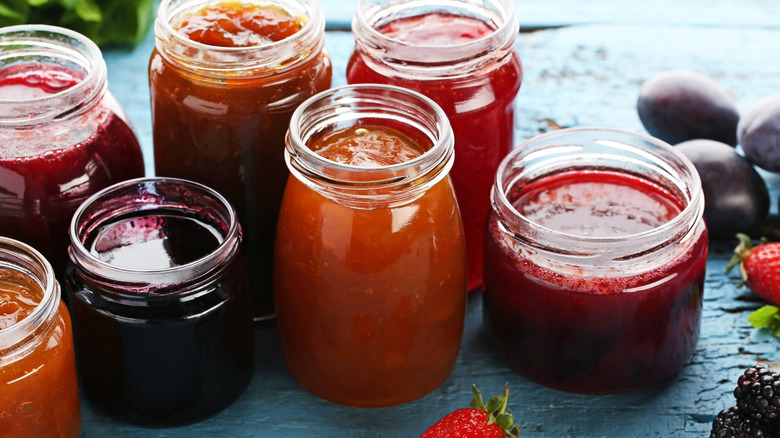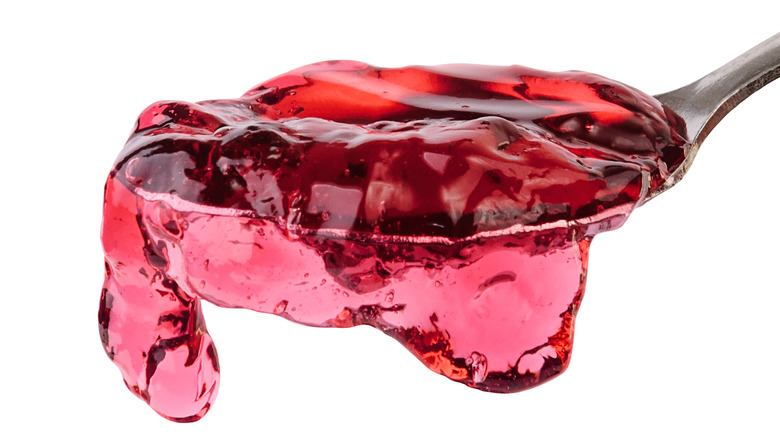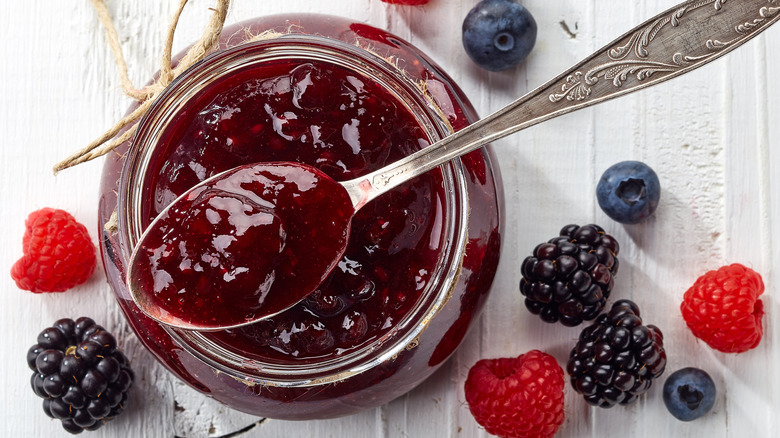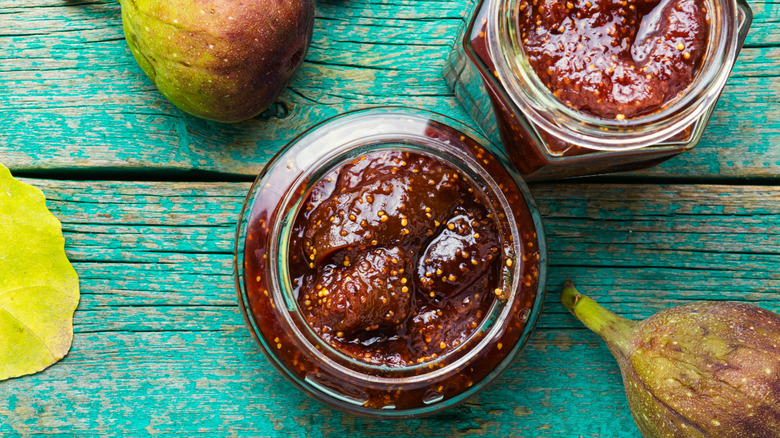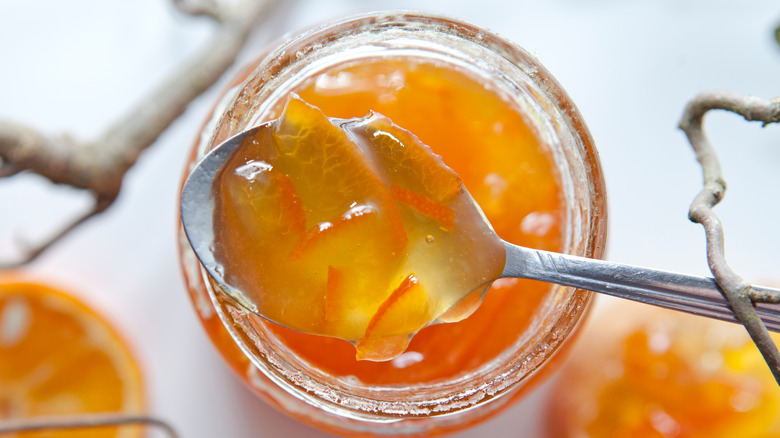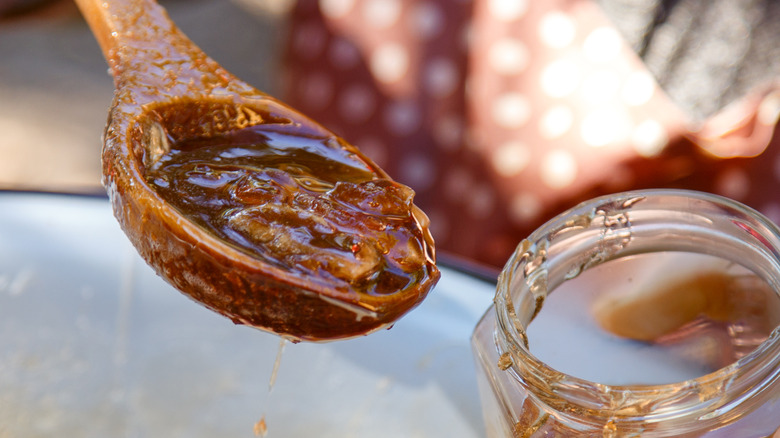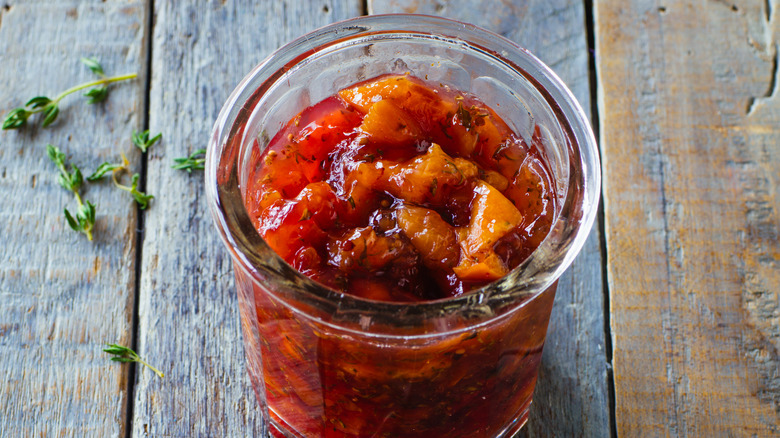Preserves Vs. Jam Vs. Jelly: What's The Difference?
What do you like to spread on your toast? Jam? Jelly? Conserves? If you're someone who tends to use these terms and others interchangeably when referring to a little jar of preserved fruit, don't worry: You're not alone! After all, they're all made with fruit, they're sweet and spreadable, and you can "put them up" in canning jars to last through the winter, right? Well, there actually are differences between all these types of preserved fruits, and what sets them apart is worth digging into, so you can find the jam or chutney or marmalade that will really make your meal spectacular.
While all these condiments begin with fruit, the differences emerge based on which fruit parts, and other ingredients, go into the mixture. According to Eater, jelly is made with only the juices of fruit, which is why it's clear with no chunks or pieces of anything in it. Jam is made from whole fruits that are mashed and cooked down, so there may be seeds or pieces of fruit in the mixture. Fine Cooking says preserves are also thick and cooked down, but have larger pieces of fruit or even whole berries. All three can also include a little or a lot of sugar, plus pectin which helps the sauce firm up.
Here's a more in-depth look at jams, jellies, and preserves, as well as a few other fruit sauces you've been wondering about.
What Is Jelly?
Let's start with jelly. According to Britannica, jelly is made by using only the juices of fruit, done by compressing the pulp and straining away all the solid pieces. Eat This, Not That! shares that pectin is what turns the juice into jelly. Pectin is a fiber that exists naturally in fruits and can also be purchased to add in. When cooked with fruit juice and an acid like lemon juice, pectin thickens the mixture so that it can set into a firm jelly. The Spruce Eats notes that some fruits have high enough amounts of naturally occurring pectin that cooks may choose not to add any more. These fruits include apples, grapes, currants, and cranberries. (As Eater points out, that solid, wiggly, canned cranberry sauce is a kind of jelly!)
According to Eat This, Not That!, straining the jelly is what leaves it transparent and easy to spread once it sets. Because jelly is made only with the juices of the fruit, and no pulp or pieces, it's considered to have less of a pure fruit flavor than jams or preserves. It's more often found as a condiment for spreading or to have on the side and less frequently called for in recipes that need a bold fruit flavor.
Wondering about the lamb accompaniment, mint jelly? Simply Recipes says it can be made infusing tart apple juice with mint, or like Martha Stewart's, with just water, mint, lots of added pectin, and green food coloring.
What Is Jam?
With jams, you get more of the real fruit in the mixture. Bon Appétit describes jam as being "chunkier" and also with a texture that differs from jelly because it's loose enough to spoon out of a jar. The fruit can be cut into small pieces, mashed as with raspberries and blackberries, or crushed to release their juices and pulp, like with blueberries and elderberries. Next, the fruit gets cooked with sugar into a thick, sweet mixture. The Pioneer Woman notes that pectin can be added to jam. But whereas the goal with jelly is to solidify the fruit sauce, with jam, pectin just helps the sauce thicken up.
Eat This, Not That! says that jams are an ideal choice if you like a thicker fruit spread since it contains the pulp of the real fruit and even seeds in jams made with berries. Stonewall Kitchen describes the texture of their Pear Cinnamon Jam as "rustic ... like homemade."
Jams, like jellies, can be preserved by canning, a process where glass mason jars full of jam are vacuum-sealed in a hot water bath. The Kitchn shares that freezer jams are also a popular way to make jam last. They're less work, too, because they don't need to be cooked. The fruit, sugar, and pectin are stirred together and left out at room temperature for hours to set. Then the jam is stored in the freezer until it's needed.
What Are Preserves?
Preserves are even closer to real fruit than jam. While jam is made with fruit that's mashed or cut into tiny pieces, Eater shares that preserves have large pieces of fruit or even whole fruit like berries. The texture of preserves can be like that of jam or have a runnier liquid base. Fine Cooking notes that preserves can sometimes look like large pieces of fruit held together in a firmer, jelly-like base. Nevertheless, the chunkier texture with large or whole pieces of fruit is what sets preserves apart from jam.
This recipe from Food.com for Cherry Preserves calls for whole, pitted cherries simmered with pectin and sugar, before being ladled into jars for canning. Chef Vivian Howard's recipe (shared with PBS) for Fig and Lemon Preserves is very specific that the figs be handled and cooked carefully so that they maintain their shape in the finished preserves.
One of the best-known brands of store-bought preserves is Bonne Maman, which uses charming red and white gingham lids. While some folks may use the terms jam and preserves interchangeably, Bonne Maman is quite clear that their specialty is preserves made with large pieces of whole fruits.
How Is Marmalade Different From Preserves?
Although marmalade is a type of preserves, because it has sizeable pieces of fruit in the mixture, it's unique because it's made with citrus. According to The Spruce Eats, marmalades have a long history and were originally made with quince. But the most popular and well-known type of marmalade is orange. Bitter oranges from Seville, Spain, are prized citruses for making marmalade because they are naturally sour and this balances well with the sugary cooking liquid.
MasterClass says that marmalade is made by simmering citrus fruits and their peels first in water to soften them and to remove excess bitterness and then in sugar to sweeten things up. Serious Eats says the citrus peel not only delivers potent flavor and texture to the marmalade, but it also has lots of pectin to help thicken the marmalade. It can be preserved in canning jars just like jelly and jam.
The Spruce Eats shares that marmalade can also be made with sweet oranges, as well as other citruses like lemon, kumquats, and grapefruit. Other flavorings are sometimes added too, like rhubarb or gingerroot to create even more intriguing marmalade flavor profiles. They also note that sometimes non-citrus fruit preserves are labeled as marmalades as a marketing strategy, but real, traditional marmalade is made with citrus.
What Are Conserves?
Conserves seem to take a little from all of the above, and add in even more! Serious Eats says that conserves can be made with a variety of fruits, including citrus, as well as dried fruits, and chopped nuts. In this Serious Eats recipe for Carrot Cake Conserves, there are veggies, too! Grated carrots are cooked with diced apples, pineapple, raisins, walnuts, and warming spices like cinnamon. The smaller size of the fruit in conserves means it can be jam-like once cooked, but with dried fruits and chopped nuts, it has more texture than jam. The Kitchn says the flavor and texture pair well with cured meats and cheeses. So you might want to consider setting conserves out on cheese or charcuterie boards.
We were already puzzled enough about the differences between jams, jellies, conserves, etc. but then Food & Wine threw in this wrinkle. They say that because jams are technically only supposed to be made from one kind of fruit, if you picked up a jam made with more than one fruit (like mixed berries or blueberry-cherry, for example), then that is actually a conserve – even if it has no nuts or dried fruit.
Is your head spinning yet? Well, hang on: There's one more to share with you!
Is Chutney Different From The Rest?
According to MasterClass, chutney is a condiment that is a bit like a relish and a bit like a jam. It hails from India and is unique from jams, jellies, and preserves because it's spicy and very often savory. Chutney is made with fruit like the others but can be made with vegetables like onions, peppers, or garlic. Serious Eats says that there are actually a huge array of chutneys, including some made with yogurt, nuts, tomatoes, coconut, tamarind, and mint. Chutneys are also typically made with vinegar, which Masterclass notes acts as a preservative along with the sugar.
Major Grey's, a mango chutney made with raisins and chopped onions, is a type of bottled chutney that's easy to find in stores. (FoodReference.com says that "Major Grey" is likely just an invented character in the style of the British military that served in India.)
Chutneys are widely varied across India; according to Serious Eats, they're specific to regions based on what is grown there. Fresh chutneys are more common in India, consisting of fruits, vegetables, and herbs ground together. The cooked chutneys, especially with fruit, were favorites of the British living in India. They brought these chutneys back to England, and they quickly grew in popularity.
MasterClass suggests trying chutneys with grilled meats, creamy cheeses, and as a side for spicy samosas.
